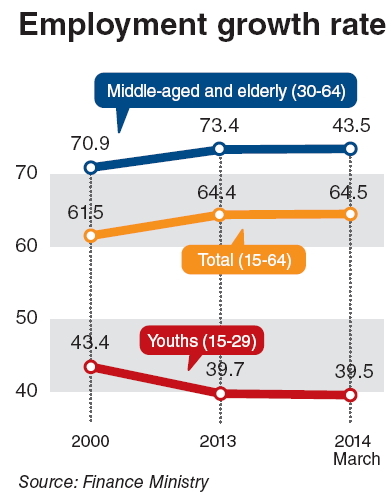The Finance Ministry announced Tuesday that it would provide young jobseekers with more opportunities by benchmarking the Switzerland-based vocational education system.
While the Swiss apprenticeship features classes one or two days per week and vocational training for three or four days at enterprises, the government said it plans to introduce the system in 2015 by modifying it in consultation with the business sector.
In Korea, students aged between 16 and 24 are likely to benefit from the latest initiative from policymakers to tackle the country’s high youth employment rate.
As a pilot operation, the ministry said it would launch three “specialized vocational high schools” and four “business-oriented schools (which would replace the academy-oriented college education).”
An official said that “after reviewing the pilot operation for next year, the government will expand the new apprenticeships across the country on a gradual basis.”
Through such measures involving some other job-creation policies, the ministry is aiming to help 500,000 young jobseekers find work by 2017.
Later in the day, Deputy Prime Minister and Finance Minister Hyun Oh-seok told a news briefing that the government was seeking to pull up the youth employment rate to the average figure held by the Organization for Economic Cooperation and Development.
“While the OECD average hovers at 50 percent, we post a 39.5 percent youth employment rate,” Hyun said. “We expect it (the low rate) will approach the 50 percent mark.”
According to Finance Ministry data, the youth employment rate is 69.7 percent in Switzerland and 50.9 percent for OECD members.
Despite improvements in Korea’s overall employment in recent years, the youth employment rate has fallen.

The overall employment rate climbed from 61.5 percent in 2000 to 64.5 percent in 2013. However, the employment rate of people aged between 15 and 29 shrank from 43.4 percent to 39.5 percent over the same period, with that of people aged between 20 and 24 years plunging 10 percentage points to 42 percent.
Officials partly attributed the low youth employment rate to a record number of people moving on to college after high school, and to a large gap between what they learn in school and what is required for their job.
A recent survey showed 93 percent of parents want their children to receive college education, and 52.3 percent of those already employed after high school wish to receive college education, even at the cost of quitting their current job.
Meanwhile, critics say the key issue is whether the business sector will welcome the policy, as firms are striving to streamline their manpower structures.
By Kim Yon-se and news reports
(
kys@heraldcorp.com)








